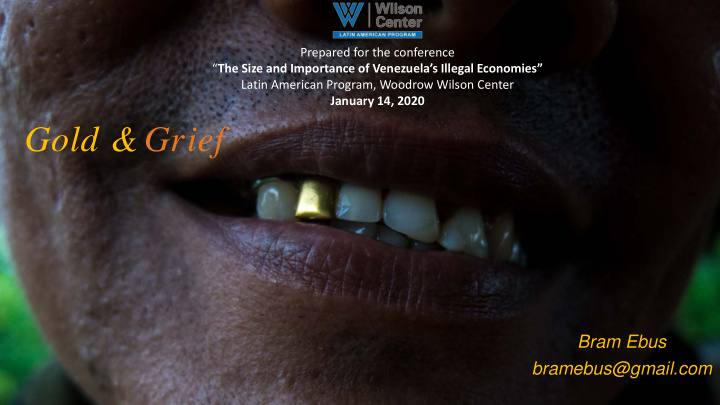



Prepared for the conference “ The Size and Importance of Venezuela’s Illegal Economies” Latin American Program, Woodrow Wilson Center January 14, 2020 Gold & Grief Bram Ebus bramebus@gmail.com
Venezuela’s mining landscape • 1853: Gold discovered in El Callao, but no strong historical mining sector. • Rudimentary (subsistence) mining by indigenous communities and m estizos. • Very limited large-scale activity in the country, wildcat expansionism. • Poverty & crisis as push-factors for rapidly expanding ASM sector since +/ -2012. Internal migration to mining areas. >500,000 persons directly or indirectly involved in mining. • Sanctions pushed the state further to gold as a means to acquire cash.
Mining in Venezuela: What is the Mining Arc? • Officially: an in 2016 decreed area of 112 thousand square kilometers for mining development. Government claims that Venezuela has the 2 nd biggest gold reserve in the world. • In practice: a legal framework around a violent and an unorganized sector providing the Maduro government with a lifeline
International investors or (non-state) armed groups? • 150 interested multinationals • Sindicatos / Pranato. announced, but nothing concrete. • ELN. • Investors, often without • FARC dissidents. experience, for example from Turkey, Palestine and the DRC. Mostly MoU. • Venezuelan security forces. • State companies – military mining enterprises.
Homicide rates per 100,000 inhabitants (2018) • El Callao (620) • Roscio (458) • Sifontes (199) • Venezuela (81,4)
Important dynamics • State complicity with armed groups & buying and processing of illegally mined gold. • Sanctions pushed the Venezuelan state further to gold as a means to acquire cash. Sanctions facilitate contraband economies and make the trade less visible. • Organized crime groups increasingly active in mining areas and border regions. • Many mining regions are home to indigenous groups, who are often deprived of their livelihoods and means of survival. Alternative survival strategies often mean participating in illegal mining economies.
Gold as alternative to cash – illicit or informal economies?
Instability at the southern borders • Guerrilla (dissident) groups along the border with Colombia. • ‘Sindicatos’ and ELN expanding over the border with Guyana. • Illegal mining projects and conflict along the border with Brazil.
Can we estimate Venezuela’s real gold production? • Exports by the BCV (Venezuelan Central Bank) include stockpiled gold and bullion acquired on international markets. • Venezuelan government officials estimate that some 30 tonnes of gold were smuggled each year until 2016. • At least 130 tonnes left Curaçao and about 30 tonnes left Aruba between 2014 and 2018. >90% of it came from Venezuela. • Unknown amounts of gold are trafficked through the Caribbean region, Colombia, Guyana, Brazil, etcetera.
Venezuelan gold production – according to the BCV • 2018: +/- 10,5 tonnes • 2019: Objective of >20 tonnes. • 2025: Objective of 80 tonnes.
Venezuelan gold incognito on international markets • A lot of attention has been given to the gold sales by the BCV, but most gold is trafficked out of Venezuela over aerial, terrestial and maritime routes. • Involvement of government allies and officials, non-state armed groups, businessmen and individuals. Cross-border crime networks and involvement of foreign entrepeneurs and state representatives. • Venezuelan gold ‘legalized’ in foreign countries as if it was produced there.
Colombia: production vs. exports.
Modus Operandi • ‘Smurfing’. • Carry-on luggage. • Cargo. • Free Trade Zones.
Destinations ’Hubs’ • United States • Aruba and Curaçao • Switzerland • The Netherlands • Belgium • Colombia • Turkey • Brazil
How deep does the problem go?
1. Revenues from mining currently provide political elites with a financial lifeline and are of paramount importance to maintaining power. 2. If countries can rely on revenues from resource extraction, taxpayers’ contributions become less important, generating a disconnect between the government and its citizens. This has been the case ever since the development of the oil industry in Venezuela. 3. Lack of transparency in government accounts, including the issue of extra- legal revenues derived from resource extraction, disenfranchises the population, and facilitates authoritarianism. 4. International stakeholders must recognize that Venezuela is not just a political battleground for C havistas and the opposition, but a country in which resource conflicts and armed groups are the norm over large swathes of the national territory. 5. UN Environment: if there is a link between conflict and natural resources, the likelihood of a relapse into conflict within the first five years after a peace deal is twice as high.
6. Relapse into conflict over resources that not only contribute to the financial empowerment of a number of non-state groups but also generate and sustain corruption in the armed forces and the government. 7. Conflict resources as an economic incentive can hinder de-escalation efforts and initiatives to negotiate in good faith with both non-state armed actors and the government elites sustained by their illegal activities. 8. There is a risk of serious conflict in southern Venezuela. A change of government or a shift in power at the executive level might throw current alliances into turmoil, causing further tensions. 9. According to the United Nations Environment Programme (or UN Environment), achieving peace by taking natural resources and the environment into consideration “is no longer an option – it is a security imperative.”
Recommend
More recommend